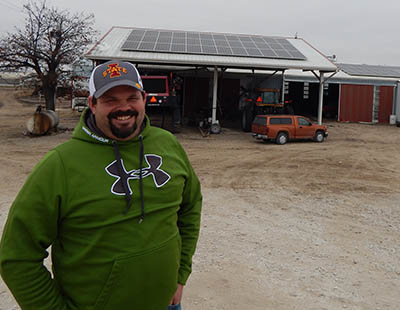
By Emery Styron
news@corridorbusiness.com
Farmer Ken Reed says he was just making a good business decision when he installed photovoltaic panels on his hog houses and shop building in 2012. But farmers talk, and Reed’s project became, in his words, “the pebble that created the tidal wave” of solar projects in Washington County.
Washington County has had more solar projects and utilized more in solar tax credits than any other Iowa county as of last year, according to Ed Raber, executive director of Washington County Economic Development Group.
From January 2012 through April 2014, Washington County had 88 solar projects, totaling $701,132 in state tax credits and representing $4.67 million in construction. That is well over double the amount of credits claimed in Dubuque County, which ranks second in the state. In fact, Washington County has utilized more than 22 percent of all the solar tax credits in Iowa, Mr. Raber said.
Figures from all of 2014 are not yet available, but Todd Miller of CB Solar in Ankeny says the number of solar projects has exploded, thanks to word of mouth among farmers, a rebate from Alliant Energy, state and federal tax credits, and other incentives.
Another catalyst for the solar boom was Farmers Electric Cooperative in northern Washington County, which offered Iowa’s first utility to implement a solar feed-in tariff, and set an aggressive goal of getting 15 percent of its power from solar by 2025. The co-op activated a solar farm in July 2014 that will generate more than 1 million kilowatt hours per year.
Mr. Reed said his own experience with solar began when he came across a CB Solar ad on Craigslist that sounded too good to be true. He called anyway.
“It was unbelievable when we started looking at the numbers,” Mr. Reed said.
Alliant Energy was offering a rebate of up to $25,000 for qualifying solar installations, in addition to a 30 percent federal tax credit, a 15 percent state credit, and a one-year tax write-off under Section 179 of the IRS tax code.
“It got [the investment] down to within months of paying for itself,” said Mr. Reed, who owns NPKK Pork, a hog confinement operation, with his brothers. “We took a tax liability, turned it around, hung it on our roof and made it an asset that made money.”
By fall of 2012, CB Solar had installed a $90,000, 30-kilowatt system on NPKK’s shop building, where feed is stored, ground and mixed, and on two hog confinement buildings.
“A neighbor called me the month after we started putting it up. More neighbors started asking and his started asking and it kept going from there,” Mr. Reed said. “This was a business decision. We weren’t trying to be the first ever.”
Ken’s brother, Paul Reed, gives Alliant’s rebate and policy of allowing reversing meters much of the credit for the county’s solar boom. No expensive batteries or energy storage systems are needed. Farmers bank credits with Alliant during hot summer months when their own energy needs are lowest and Alliant’s peak load is highest. Those credits lower farmers’ costs in the winter when energy needs are highest.
It all added up to a perfect storm for solar vendors. Farmers were coming off their best years in decades and looking for investments. Land prices were high, but solar tax credits and incentives were tempting. So was the chance to hedge against utility rate increases.
CB Solar was one of several vendors to ride the wave. By late fall 2014, CB Solar had installed 222 solar arrays in Washington County, with an aggregate capacity of 4 megawatts.
“Once we get an array up, it acts as a billboard for us,” said CB Solar sales manager Todd Miller.
Alliant’s rebate, which expired in 2013, drove business. Customers had most of 2014 to get their systems installed. The end of the rebate “really slowed it down,” Mr. Miller said. “Instead of taking orders, it’s more of a sales process now.”
Ample incentives are still in place. The federal tax credit and Section 179 write-off remains, and the Iowa tax credit is now 18 percent. The U.S. Department of Agriculture offers 25 percent Rural Energy for America (REAP) grants up to $500,000 for renewable energy systems for ag producers and small businesses. Iowa also offers a low-cost renewable energy loan program.
Major commercial projects have also come online in Washington County. Engineered Building Design (EBD), a truss manufacturer in Washington, turned on its 100-kilowatt solar array in late November, and expects a five-year payback on its $281,000 investment.
EBD’s bought the system from Integrated Power Corporation, or iPower, a California company owned by former Iowa and NFL footballer Tim Dwight. EBD co-owner Dave Mitchell expects the 352-panel photovoltaic ground array to offset a third of the company’s electrical use.
“We view it as an insurance policy on future rate increases,” Mr. Mitchell said.
Ace-N-More hardware in Washington turned on a 120-kilowatt ground-mounted system Dec. 26.
“She’s making power every day. December was pretty poor but this month’s been sunny almost every day,” store owner Craig Jones said. He bought the 200-ft. long, 438-panel system from EPO Energy of Cedar Falls.
At the south edge of Washington County, a new $812,000 system in the Waco School District powers the lighting for the athletic fields and is expected to save the district $100,000 per year on its electric bill. The system was installed by Atwood Electric of Sigourney.
Though the Alliant rebate has expired, solar projects remain attractive. NPPK has contracted for another 30-kilowatt sys- tem, this time utilizing a REAP grant.
Mr. Miller of CB Solar expects solar demand to continue.
“Farmers, as any business owner, don’t like to pay taxes,” he said. “This is like buying machinery, but the difference with solar is that it will actually lower your operational cost every single year.”




